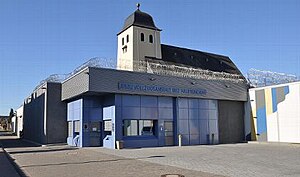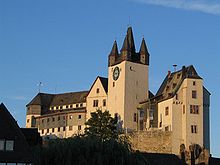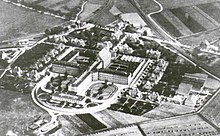Prison and preventive detention facility Diez
 Correctional u. Preventive detention facility Diez main gate with a view of the church tower |
|
| Information about the institution | |
|---|---|
| Surname | Prison Diez |
| Reference year | 1912 |
| Detention places | 617 |
The Diez correctional facility and preventive detention facility is the largest long-term prison facility in the state of Rhineland-Palatinate . It is located on the eastern outskirts of Diez and is one of eight penal institutions in Rhineland-Palatinate , but the only one in which custodial sentences from eight years to life imprisonment are carried out for adult men.
location
The Diez prison and security facility is located near the intersection of Landstrasse 417 and Bundesstrasse 54. The Diez-Ost train station on the Oberwesterwaldbahn and Unterwesterwaldbahn is also near the prison .
history
The history of the serving of sentences in Diez goes back to the 18th century. Between 1778 and 1779 the Grafenschloss Diez was rebuilt for this purpose under building inspector Johann Friedrich Sckell and expanded in 1806. It later served as a prison for the Duchy of Nassau . In 1811 the Nassau prison in Weilburg was closed and the inmates were relocated to Diez. The prisoners were obliged to do manual work, whereby the processing of Lahn marble from the neighboring quarries played a special role. The Diezer Zuchthausfabrik subsequently attained a dominant position in marble processing and also manufactured the marble border columns in the Duchy of Nassau.
Due to the annexation of the duchy by Prussia in 1866 and the expansion of the catchment area, the prison in the castle was considered too small at the end of the 19th century. In addition, the facilities no longer corresponded to the desired structural, safety and sanitary conditions, so that a new building in the neighboring municipality of Freiendiez , a district of Diez since the incorporation in 1939, was decided.
A number of well-known prisoners were held in Diez after the Second World War, including the Nazi war criminal and later head of the State Criminal Police Office (LKA) Rhineland-Palatinate Georg Heuser and the violent criminal Dieter Freese . The terrorists Manfred Grashof , Klaus Jünschke and, in mid-1972 , Ulrich Schmücker, who was later killed in a fememicide, were held in the Red Army faction .
In 2013, the Diez penal institution, the largest in the state, entered into a partnership with the Limburg penal institution , the smallest penitentiary in the state of Hesse, just 3 kilometers away .
Building complex
In July 1907, construction began on the new Freiendiez prison in the field of the municipality of Freiendiez, on the old country road to Limburg , not far from the confluence of the Unterwesterwaldbahn and Lahntalbahn . It was completed in 1912 after six years of construction. The first prisoners moved into the central prison in 1912, but the castle was not completely abandoned as a penal institution until 1928.
As is often the case with prison buildings, the cell wings are built in a panoptic construction . A surveillance stand was set up in the center of the cross-shaped building, from which all corridors and cell doors could be observed. The new building was one of the first buildings to be equipped with electric lighting instead of gas light. For the prison staff, 61 apartments were built along the outer walls in the Wilhelminian style of that time, as residence was compulsory for the staff . The entire property is a listed building.
time of the nationalsocialism
In the detention center Freiendiez of Nazism were (the independent village was incorporated into the City Diez 1938) from 1935 numerous opponents admitted treason and from there to the concentration camp transferred. In the immediate vicinity of the Diez prison, the Limburg XII A main camp was established from 1939 to the beginning of 1940 , which then served as a transit camp (Dulag) until the end of the war . It was intended for around 43,000 prisoners of war housed at the same time and was occupied mainly by Belgians, French, British, Poles, Russians, Americans and Italians. In the event of violations, prisoners of war were transferred to the Diez prison, which was occupied by German prisoners, where death sentences were also carried out. In the autumn of 1944, 16 young Luxembourg men were executed. From 1942, foreign prisoners of the night and fog were imprisoned in Diez. Contemporary witnesses speak of poor living conditions and abuse.
Present function
The Diez JVA has room for 494 adult male prisoners in the closed and 59 adult male prisoners in the open prison. Similarly, is preventive detention (of men) in Rhineland-Palatinate and the Saarland carried out exclusively in the prison Diez. A separate building complex was put into operation in 2013 to accommodate those in preventive detention, with up to 64 places available.
The model project "Education in Preventive Detention " of the Catholic Adult Education Rhineland-Palatinate and the Catholic Prison Chaplaincy was carried out in the prison .
Enforcement jurisdiction
As of September 1, 2014, the Ministry of Justice and Consumer Protection regulated enforcement jurisdiction as follows:
- Life imprisonment for the whole of Rhineland-Palatinate
- Imprisonment with ordered or reserved preventive detention for the whole of Rhineland-Palatinate
- Prison sentences from eight years of age to prisoners residing in the district court districts of Kaiserslautern, Landau and Zweibrücken
- Imprisonment from five years to prisoners residing in the district court districts of Bad Kreuznach, Frankenthal, Mainz and Trier
- Prison sentences of two years or more for prisoners residing in the district court district Koblenz
- Imprisonment for prisoners in accordance with § 24 LJVollzG
- Enforcement of preventive detention for the whole of Rhineland-Palatinate and Saarland
- Open execution for prisoners residing in the district court district of Koblenz with a prison sentence still to be served for over a year
- Open execution for people in preventive detention from all over Rhineland-Palatinate and Saarland
Own operations within the prison
JVA Diez has several own operations:
literature
- Jünschke, Klaus: Spätlese: Texts on RAF and prison , Frankfurt am Main, New Critique Verlag, 1988
- Klein, Peter: Possibilities of co-responsibility of the inmates in the guard-oriented prison system: an investigation on the basis of the questioning of officials u. Inmates of the Diez correctional facility , University of Mainz, dissertation, 1981
- Prison in Diez (ed.): Prison in Diez. 100 years of Freiendiez Prison, Diez Prison 1912-2012. A chronicle in texts, reports from contemporary witnesses, sources and pictures. Texts: Adolf Morlang, Barbara Wieland. Editor: Rainer Dittmann, Diez 2012.
Web links
- JVA website
- rlp.de: ( Page no longer available , search in web archives: Minister Bamberger visits Diez correctional facility )
- rhein-lahn-info.de: ( Page no longer available , search in web archives: A closed society as a "small community" in Diez )
Individual evidence
- ↑ Enforcement plan of JVA Diez on justiz.rlp.de
- ↑ Petra, Helga Reucker and Thomas Kirnbauer Schwenzer: The marble border columns of the Duchy of Nassau , Association for Nassau antiquity and historical research, Wiesbaden, 1982, p. 346 ff
- ↑ 50 years after the robbery: Is "gang boss" Freese still alive? ( Memento from April 17, 2012 in the Internet Archive ) In: Rhein-Zeitung from February 14, 2012
- ↑ Der Spiegel : The fatal meeting of October 7, 1974.
- ↑ Gabriele Goette / Taz : Where lock and bolt for ... A former prison chaplain tells of December 29, 2008.
- ↑ General Directorate for Cultural Heritage Rhineland-Palatinate
- ↑ website forced labor in the Kirche.de
- ^ Report from the Diez prison pastor Kneip from 1945
- ↑ Frank Falla Archive: Brits in Diez Prison during World War II
- ↑ http://www.justiz.rlp.de/Justizvollzug/JVA-Diez/Zustaendigkeit/
- ↑ a b http://www.keb-rheinland-pfalz.de/pdf/Antrag_BiS_8%20aktuell.doc
Coordinates: 50 ° 22 ′ 30.7 " N , 8 ° 2 ′ 11.4" E

